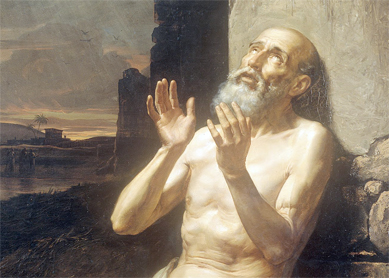William Blake (1757–1827) was a man of ferocious intellect and vigorous imagination. Poet, theologian, engraver, painter, and illustrator, his 22 plates for the book of Job are rich in biblical imagery and symbolism. Blake does not merely provide illustrations for the biblical text—in his hands, Job becomes an Everyman undergoing a Last Judgment, a graphic example of the spiritual journey a man’s soul must take from prideful ignorance and false religion, enduring trials and terrifying visions of a devil-god, to enlightened divine humanity, blessed and free.
Blake saw himself as a poet-prophet in the lineage of Ezekiel, Isaiah, and Jeremiah. His writings and illustrations intend to provoke spiritual revelations in the imaginations of his readers. For Blake, imagination is the universal incarnation of divinity in humanity. Following the teachings of Emanuel Swedenborg and Jacob Boehme, he constructs a symbolic universe in which every element of each plate offers a deeper spiritual meaning. Even the background landscapes correlate with the state of Job’s soul. For example, in plate 2 the images framed by billowing clouds tell the reader that this vision is taking place in Job’s imagination. The angel of the divine presence sits on a throne, the book of the law open in his lap, mirroring Job at the bottom of the picture, who holds the book open on his knee. The angel closely resembles Job, a highly significant point in Blake’s theology. Referring to
Blake was fascinated by Job’s trials and returned to the story again and again. Not satisfied with the common understandings that the narrative presented an arrangement between God and Satan to test Job’s status as a “man of faith” or that it provided an answer to the difficult question of why bad things happen to good people, Blake saw Job undergoing material and spiritual suffering in order to begin his search for the true God. For Blake, traditional religious forms and the new natural sciences restrained the poetic genius at the root of the universal religion of divine humanity. As Blake understood it, “The Last Judgement is not Fable or Allegory but Vision” (A Vision of the Last Judgement). “If the doors of perception were cleansed every thing would appear to man as it is, infinite” (The Marriage of Heaven and Hell). His Illustrations of the Book of Job attempt to unveil something of the soul’s journey into this vision.




